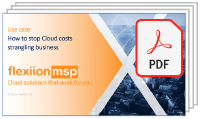Once the tech is running, it’s the business that matters in the Cloud
 Once the devs have worked their magic and the tech is running and doing what it should, the challenges move to business: getting the service to customes and users reliably, at scale, and profitably. This is where the business challenges begin as the costs issues and workloads emerge, risks become clearer, and the changing needs of customers and the business shift and develop. It’s the business concerns that rule eventually, and chief among those concerns is costs: can this technology solution be delivered economically?
Once the devs have worked their magic and the tech is running and doing what it should, the challenges move to business: getting the service to customes and users reliably, at scale, and profitably. This is where the business challenges begin as the costs issues and workloads emerge, risks become clearer, and the changing needs of customers and the business shift and develop. It’s the business concerns that rule eventually, and chief among those concerns is costs: can this technology solution be delivered economically?
Cloud costs can rise faster than income
Cloud cost structures are often complex and arcane, with several different charge streams running in parallel. In particular, though, it can be very hard to get to the bottom of how the dynamics of these charges will add up as usage scales. A good rule of thumb is that you won’t know the costs exactly until the usage has happened and the charges are a matter of fact.
Cloud seems attractive because you pay for what you use, but that flexibility comes at a price, in just the same way as taking a taxi is more expensive per mile than if you own the vehicle. Well, this is true if you only have a few journeys. As with taxis, so with Cloud: the costs can rack up and become unsustainable if your usage on these flexible prices goes above a certain point.
Understanding the dynamics of what drives pricing is crucial to running a business that’s scaling in the Cloud. This, with the nature of your service, determins what structure and architecture of Cloud services makes economic sense for your business. This is where business considerations – not technology – drives what type of Cloud service to use for the different components of your sevice, which provider is best suited, and even which parts might be best not delivered from the Cloud at all.
Hotel California has come to a Cloud near you
The Cloud is a lovely place. It’s seductively easy to get going, to spin up services and start. Adding more services is just a button click away. It’s often free to send data, and usually almost free to store it. You only pay for what you use, right? Yes, this is true, kind of, but it’s not really as simple as this if you want to leave.
There are often extra costs to get your data out – known as data egress charges. There are other traps. Branded providers of Cloud often have special services available that make it even easier and faster to create your application, get it running and delivering service to users. These extras are great but they all work in different ways, which means that moving to another Cloud provider would require the cost and disruption of a rebuild.
You can check out any time you want but you can never leave, unless you have been careful from the outset, to choose how your business structures the way it uses Cloud. Avoid the traps that can lock you in as you scale and change.
Housekeeping and support are the boring overheads that get overlooked
Delivering services from the Cloud at scale, reliably, is not a part time concern. Cloud infrastructure doesn’t look after itself. It needs time and attention, and the right expertise and management processes. All too often these everyday responsibilities are left to dev teams that are already working flat out on technology with other imperatives, and service quality suffers as a result.
There are two, key workstreams that are needed for Cloud infrastructure to be adequately resilient and fit for the job of delivering service from software. First, is the routine of patches, updates, security maintenance, and all the other activities needed to keep the systems in good shape. These tasks make up a somewhat thankless, general routine that often gets overlooked by teams with deadlines to meet.
Second, is the live monitoring of service and performance needed to spot emerging problems and the outages that always happen eventully, and bring down the service expected by customers and users. This active vigilance will aim to be as proactive as possible, to identify issues and trigger early fixes that bring the services back up and running as fast as possible, to keep disruption to a minimum.
The skills sets and management processes to deliver housekeeping and rapid problem spot and fix are needed to underpin service quality and the expectations customers and others have, often 24×7.
While these add to the costs of delivering service from the Cloud, specialist support firms can provide what’s needed round the clock at lower and more manageable cost than is possible for many through adding teams to the payroll.
Flexiion is one of the new breed of independent Cloud support firms that specialise in the business of managing and supporting Cloud solutions in an operational and scaling environment.
Peter is chairman of Flexiion and has a number of other business interests. (c) 2021, Peter Osborn